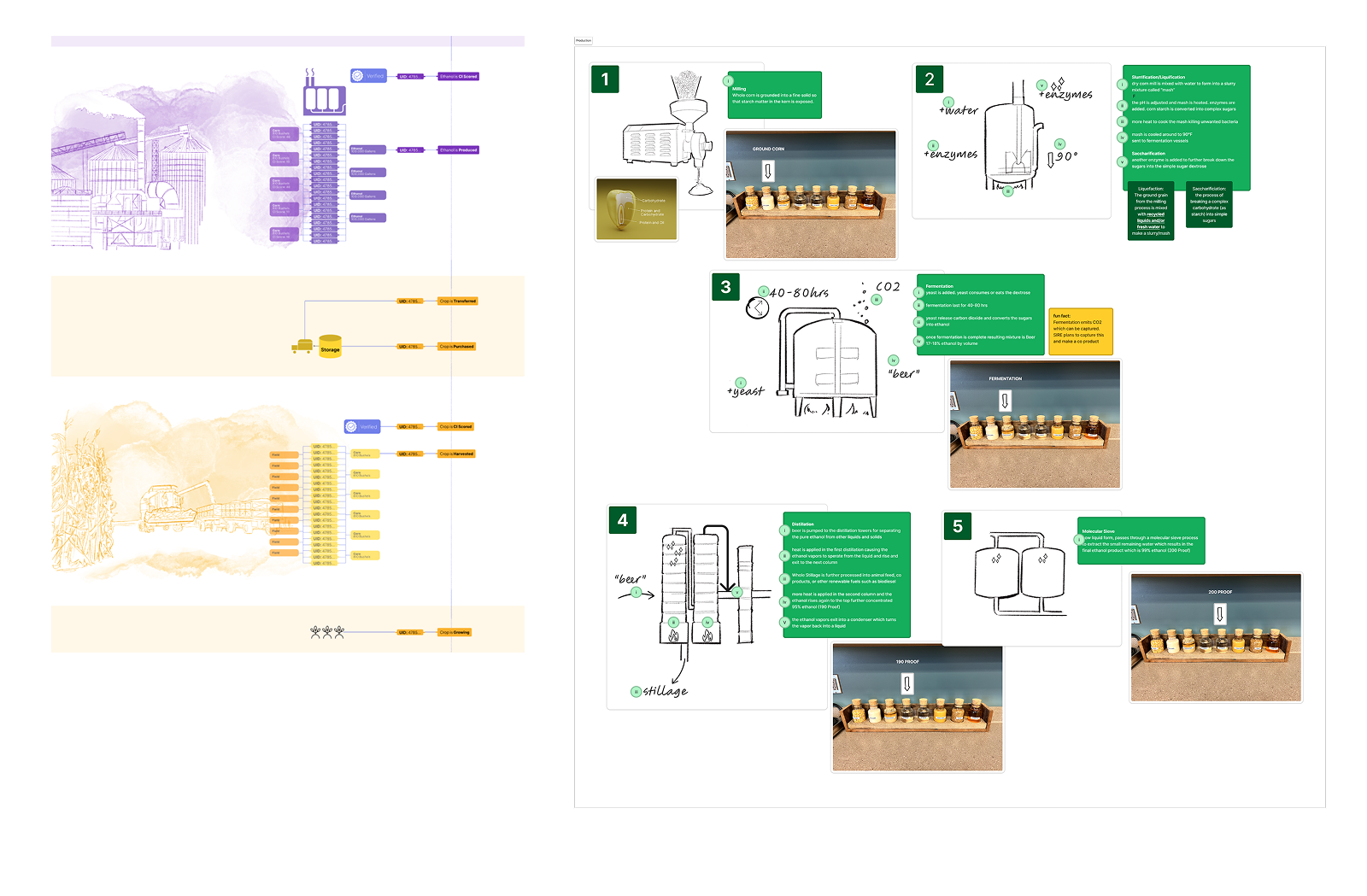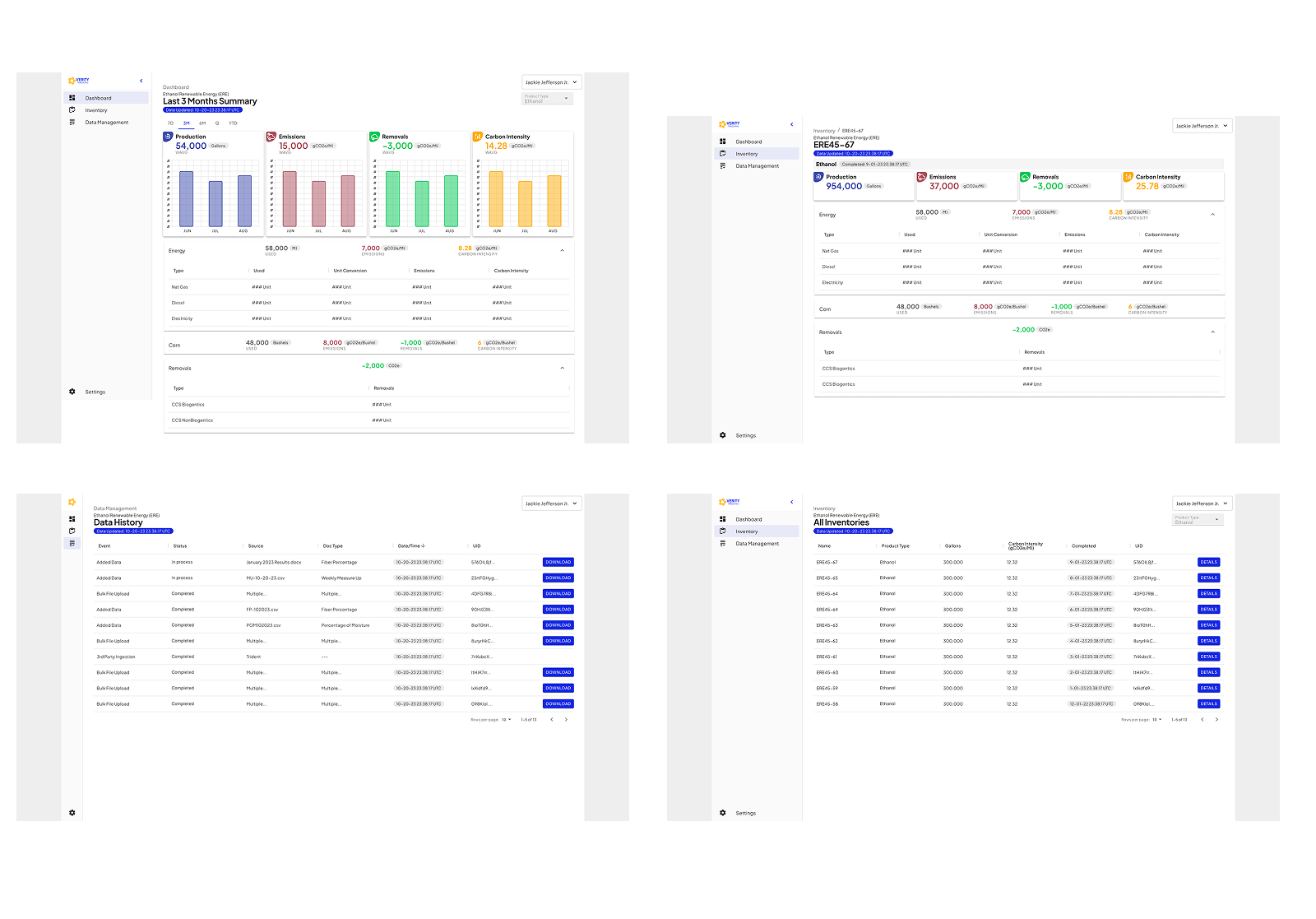

Gevo approached the Verity team with a clear challenge: visualize and quantify carbon emissions across the agricultural supply chain — from growing corn to producing ethanol. The business problem centered on enabling transparency and accountability for sustainable production. Without a centralized dashboard, farmers and ethanol producers lacked a unified way to monitor emissions and demonstrate compliance with clean energy initiatives.
From a user perspective, farmers had no accessible method to prove their low-emission practices. This limited their ability to access premium markets or sustainability credits. Ethanol producers, in turn, struggled to verify and report emissions data from their corn suppliers, creating friction across the supply chain.
Through extensive learning sessions with corn farmers, ethanol producers, agricultural scientists, and sustainability experts, we discovered that data acquisition, not calculation, was the bottleneck. The existing workflows were fragmented, relying heavily on spreadsheets, phone calls, and manual data entry. By solving this, we could empower users to self-serve — generating emissions reports independently, accelerating compliance, and unlocking new revenue channels tied to sustainable agriculture.
Key insights gained included:

In the ideation phase, collaboration was critical. The CEO, three data scientists, a lead engineer, and I worked closely to conceptualize a dashboard that served both farmers and ethanol producers. Our early whiteboard sessions revolved around connecting two major touchpoints: corn production data and ethanol processing data — both visualized as part of one transparent emissions story.
We explored multiple approaches: a complex analytical dashboard vs. a simplified experience highlighting key metrics like CO₂ reduction and efficiency per yield. After testing a few conceptual layouts, we prioritized clarity and scalability— designing a dashboard that started with essential KPIs but could later expand to show supply chain links, audit trails, and historical performance.
Ultimately, we developed a roadmap that phased delivery over seven months, ensuring an MVP that demonstrated immediate business value while leaving room for advanced analytics in future iterations. This approach balanced innovation with practicality, helping secure stakeholder buy-in early.

As the sole designer, I collaborated directly with the CEO, lead data engineer, and frontend team to translate data complexity into clear visual storytelling. The MVP dashboard design centered on two user types — farmers (data input + emissions overview) and ethanol producers (supply chain view + validation).
We began with low-fidelity wireframes to define structure, moving quickly into high-fidelity prototypes built in Figma. The design system was modular and data-driven, ensuring components like charts, filters, and report summaries could adapt to future feature expansions.
Throughout the design process, I applied usability heuristics such as visibility of system status and recognition over recall, combined with accessibility best practices to ensure legibility and interaction simplicity. Feedback loops with engineers and data scientists kept designs grounded in feasibility, while early visual reviews with leadership focused on clarity, brand consistency, and scalability.
By the end of this phase, we had a cohesive UI library, a validated design structure, and an interactive prototype ready for stakeholder testing.

The prototype was built in close collaboration with engineers, who developed a semi-functional demo using real-world sample data. This allowed stakeholders and potential investors to experience the dashboard as a near-live environment.
Our goal during testing was to validate whether farmers and ethanol producers could easily interpret and interact with emissions data without needing expert assistance. Sessions with agricultural SMEs and sustainability experts confirmed that the information hierarchy made sense, though we identified a few areas for improvement in terminology and data labeling.
One major insight was that users appreciated visual storytelling — seeing emissions trends over time through graphs rather than raw numerical tables. This led to adjustments in chart interactions and color systems to communicate impact at a glance. Leadership’s feedback was overwhelmingly positive, affirming the MVP’s strong foundation for scaling into a more comprehensive sustainability suite.

Once the prototype was approved, I prepared a full Figma design package including component specifications, typography hierarchy, and spacing standards. Interactive flows were linked directly in Figma Inspect, ensuring the engineering team could easily extract assets and measurements.
Handoff was managed through Notion documentation and Jira tickets, where each component and flow was mapped to a corresponding development task. I also hosted a final design review and Q&A session to ensure engineers understood interaction logic and responsive behavior.
Continuous collaboration was maintained during implementation — especially regarding dynamic data states and loading feedback — ensuring the final product matched the intended experience.

The MVP launched internally as a beta dashboard to a select group of farmers and ethanol producers. The overall development timeline from design to soft launch took approximately three months.
The launch process included internal demos for leadership, followed by a controlled release to test usability and data accuracy in real farming scenarios. One of the biggest challenges was reconciling live emissions data with inconsistent field reporting formats — an issue the data team later addressed through automation.
Despite the complexity, the MVP launch was a success. It became a functional proof of concept that demonstrated how transparent emissions reporting could transform agricultural value chains.
To measure impact, we focused on early adoption metrics: number of active test users, frequency of report generation, and time-to-complete emissions documentation. Within the first month, user engagement exceeded expectations — farmers reported reduced time preparing emissions data by over 40%, and producers cited improved confidence in supply chain transparency.
Qualitative feedback reinforced that the dashboard gave users a tangible sense of control over their sustainability story. Leadership saw clear potential to extend the tool’s framework to other renewable fuel programs.
Post-launch, the biggest lesson learned was the importance of data storytelling — users didn’t just need numbers, they needed context. For future iterations, I planned to expand visualizations that link emissions savings directly to economic benefits, creating a stronger feedback loop between sustainability and profit.